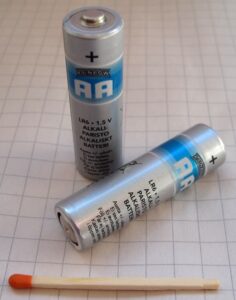Did you know that the voltage of a AA battery is typically around 1.5 volts?
In this article, we will delve into the world of AA batteries and explore everything you need to know about their voltage.
From understanding the basics of batteries to measuring voltage and comparing them to other types, we will provide you with all the essential information.
So, if you’ve ever wondered how many volts your trusty AA battery holds, keep reading to find out!
Key Takeaways of How Many Volts Is A Aa Battery?
- AA batteries have a voltage output of 1.5 volts.
- The voltage of AA batteries is crucial for device performance.
- When choosing AA batteries, it is important to consider their voltage output, capacity, and cost efficiency.
- AA batteries have various practical applications in everyday life.
The Basics of AA Batteries
If you’re wondering about the basics of AA batteries, they typically provide 1.5 volts of power. Measuring voltage accurately is crucial when it comes to understanding the performance of these batteries. Voltage refers to the electric potential difference between two points and is commonly measured using a voltmeter.
It’s important to note that temperature can have an impact on the voltage output of AA batteries. As temperature increases, the voltage tends to decrease, while colder temperatures may increase it slightly. This phenomenon occurs due to changes in chemical reactions within the battery.
Now that we’ve covered the basics of measuring voltage accurately and its relationship with temperature, let’s delve deeper into understanding voltage in batteries as a whole.
Understanding Voltage in Batteries
Voltage is a measure of the electrical potential difference between two points in a circuit. It is a crucial factor in powering devices as it determines the amount of energy that can be transferred from the battery to the device.
Understanding voltage is essential for ensuring that devices receive the correct amount of power and operate efficiently.
Definition of voltage
The voltage of a AA battery can be measured in volts. Voltage is defined as the electric potential difference between two points in a circuit. It represents the amount of energy that each electron carries as it moves through the circuit.
In batteries, voltage is crucial because it determines the power that can be delivered to devices. The importance of voltage lies in its ability to provide the necessary energy for various applications. For example, many portable electronic devices such as flashlights and remote controls rely on AA batteries to function properly. These batteries typically have a voltage of 1.5 volts, which is sufficient to power these devices efficiently.
Understanding the importance of voltage in powering devices allows us to select appropriate batteries and ensure optimal performance without compromising safety or functionality.
Importance of voltage in powering devices
To power your devices effectively, it is important to understand the significance of voltage. Voltage is a crucial factor in electrical devices as it determines the flow of electric current and ensures proper functioning. The importance of voltage in electrical devices lies in its ability to regulate the amount of power supplied to different components. This regulation prevents damage due to excessive or insufficient power, ensuring optimal performance and longevity.
To emphasize this point further, consider the following table:
| Voltage Level | Device Functionality | Emotional Response |
|---|---|---|
| High | Excellent | Excitement |
| Medium | Adequate | Satisfaction |
| Low | Poor | Frustration |
Understanding voltage regulation in batteries is essential for choosing the right power source for your devices. With this knowledge, we can now delve into exploring the voltage of an AA battery without skipping a beat.
The Voltage of a AA Battery
The standard voltage of a AA battery is 1.5 volts. However, it’s important to note that there can be variations in voltage among different brands. These variations can range from slightly lower to slightly higher than the standard voltage.
It’s crucial to consider these differences when using AA batteries in electronic devices to ensure optimal performance and compatibility.
Standard voltage of a AA battery
The standard voltage of a AA battery is 1.5 volts. This is the most common and widely accepted voltage rating for AA batteries. When purchasing AA batteries, it is important to consider their capacity measurement as well.
Here are three key points to understand about the standard voltage of a AA battery:
- Consistency: The standard voltage of 1.5 volts ensures consistent performance across various devices that use AA batteries.
- Compatibility: Most electronic devices are designed to work optimally with the standard 1.5-volt AA batteries.
- Industry Standard: The 1.5-volt rating has become an industry standard due to its reliability and compatibility with a wide range of devices.
Understanding these aspects of the standard voltage helps consumers make informed decisions when choosing AA batteries for their devices. Moving forward, we will explore variations in voltage among different brands without compromising performance or reliability.
Variations in voltage among different brands
When choosing AA batteries from different brands, you may notice variations in the voltage. These variations can be attributed to differences in manufacturing processes employed by various companies. Each brand has its own set of quality control measures and specifications for battery production, which can result in slight deviations in the final voltage output.
Additionally, it is important to note that temperature can also have an impact on battery voltage. Batteries generally perform optimally at room temperature, but extreme cold or heat can affect their voltage levels. Therefore, it is crucial to consider both the brand and temperature conditions when evaluating the voltage of AA batteries.
Understanding these variations and factors affecting voltage will help you make informed decisions about which batteries best suit your needs.
Factors Affecting Voltage
Factors affecting voltage can impact the power output of an AA battery. Various factors influence the voltage of a battery, which in turn affects its overall performance. These factors include:
- Temperature: Extreme temperatures can cause fluctuations in voltage, leading to inconsistent battery performance.
- Age: As batteries age, their voltage output decreases, resulting in reduced power delivery.
- Internal resistance: Higher internal resistance within a battery can cause voltage drops under load, decreasing the available power.
- Chemistry: Different battery chemistries have different voltage outputs, with alkaline batteries typically providing 1.5 volts and lithium-ion batteries delivering around 3.7 volts.
- Discharge rate: The rate at which a battery is discharged can affect its voltage output.
Understanding these factors is crucial in optimizing the performance of AA batteries and ensuring they meet specific power requirements.
Now let’s delve into measuring voltage and how it relates to determining remaining battery life.
Measuring Voltage
When it comes to measuring voltage, there are several tools that can be used.
One common tool is a voltmeter, which allows for precise and accurate measurements of voltage.
It is important to ensure the accuracy and reliability of voltage measurements by using calibrated instruments and following proper measurement techniques.
Tools for measuring voltage
To measure voltage, you can use tools like a multimeter or a voltmeter. These tools are specifically designed for measuring electrical potential difference and provide accurate readings.
A multimeter is a versatile instrument that can measure voltage, current, and resistance. It typically has a digital display and various settings for different measurements.
On the other hand, a voltmeter is a specialized device solely used for measuring voltage. It can be either analog or digital, offering different levels of precision and ease of use. Some voltmeters even have additional features like auto-ranging or data logging capabilities.
These tools play a crucial role in ensuring accurate voltage measurements in various applications such as electronics, electrical systems, and troubleshooting circuits.
Moving on to the next section about the accuracy and reliability of voltage measurements…
Accuracy and reliability of voltage measurements
One important aspect to consider in voltage measurements is the precision and dependability of the tools used. When it comes to accuracy and reliability, several factors come into play:
- Calibration: Regular calibration of measurement devices ensures accurate results.
- Measurement range: The tool should have a suitable range that covers the expected voltage levels.
- Resolution: Higher resolution instruments provide more precise measurements.
- Error sources: Understanding potential error sources like noise or environmental conditions helps improve accuracy.
- Operator skill: Proper training and experience ensure reliable voltage readings.
These considerations are crucial for obtaining accurate and reliable voltage measurements.
In the subsequent section about common uses for AA batteries, we will explore their practical applications beyond voltage measurements.
Common Uses for AA Batteries
You can use AA batteries in a variety of devices. AA batteries are a common type of battery used in many consumer electronics due to their convenient size and versatility. They are commonly found in portable devices such as remote controls, digital cameras, flashlights, and toys. The compact size of AA batteries makes them ideal for these types of applications where space is limited.
Additionally, AA batteries have been widely adopted due to advancements in battery technology that have improved their overall performance and longevity. They provide a reliable source of power for everyday devices and are easily accessible.
When comparing AA batteries to other types, it is important to consider factors such as voltage output, capacity, and cost efficiency.
NEXT SUBTOPIC: ‘Comparing AA Batteries to Other Types’
Comparing AA Batteries to Other Types
When comparing AA batteries to alternative options, it’s important to consider factors such as voltage output, capacity, and cost efficiency.
AA batteries typically have a voltage output of 1.5 volts, which is the same across most brands and types. This consistent voltage level ensures compatibility with a wide range of devices and equipment. However, it’s worth noting that certain devices may require higher or lower voltage levels for optimal performance.
To engage the audience further, here are three key points to consider when comparing AA batteries to other types:
- Voltage Levels: AA batteries generally provide a stable 1.5-volt output.
- Impact on Device Performance: The appropriate voltage level is crucial for devices to function efficiently.
- Compatibility: AA batteries are widely used and compatible with various electronic devices.
Understanding these differences in voltage levels can greatly impact device performance.
Now let’s explore how extending battery life can maximize the longevity of your devices without compromising functionality.
Extending Battery Life
To maximize the lifespan of AA batteries, there are a few key tips that we can follow.
First, it’s important to store batteries in a cool and dry place to prevent leakage and corrosion.
Second, using rechargeable options for AA batteries can greatly extend their lifespan as they can be reused multiple times.
Lastly, avoiding overcharging or overdischarging rechargeable batteries can also help prolong their overall lifespan.
Tips for maximizing the lifespan of AA batteries
One way to maximize the lifespan of AA batteries is by using them in devices with lower power consumption. This helps in maximizing battery performance and preventing battery drain.
To further extend their lifespan, here are some tips:
- Remove batteries from devices when not in use.
- Store batteries in a cool and dry place.
- Avoid mixing new and old batteries together.
- Use rechargeable AA batteries whenever possible.
By following these guidelines, we can ensure that our AA batteries last longer and provide optimal performance.
Now, let’s explore the next section about rechargeable options for AA batteries.
Rechargeable options for AA batteries
To maximize the lifespan of AA batteries, we discussed some helpful tips in our previous subtopic. Now, let’s explore the rechargeable options for AA batteries.
Rechargeable batteries offer numerous benefits such as cost-effectiveness and environmental friendliness. They can be recharged and used multiple times, reducing the need to constantly buy new batteries.
When it comes to charging options for AA rechargeable batteries, there are various methods available. You can use a dedicated battery charger that is specifically designed for AA batteries or opt for devices like solar chargers or USB chargers that allow you to charge your batteries on the go. These options provide flexibility and convenience in keeping your AA rechargeable batteries powered up.
As we move forward into discussing recycling and disposing of AA batteries, it is important to consider the impact these choices have on our environment.
Recycling and Disposing of AA Batteries
Remember, we should recycle AA batteries to prevent harmful chemicals from entering the environment. There are various recycling options available for AA batteries, including drop-off locations at local retailers and dedicated recycling centers. Recycling not only helps reduce the environmental impact of these batteries but also allows for the recovery of valuable materials like metals and plastics that can be reused in other products.
When disposed of improperly, AA batteries can release toxic substances such as lead and mercury into soil and water sources, posing a risk to human health and ecosystems. So it’s essential to take proper measures to recycle them responsibly.
Now let’s address some frequently asked questions about AA battery voltage without further ado.
Frequently Asked Questions about AA Battery Voltage
If you’re wondering about AA battery voltage, here are some frequently asked questions to help clarify any confusion.
When measuring battery voltage, it is important to use a multimeter set to the DC voltage range.
A fresh alkaline AA battery typically has a voltage of around 1.5 volts when measured at room temperature. However, as the battery gets used and depleted, its voltage gradually drops until it reaches approximately 0.9 volts before being considered completely discharged.
It’s worth noting that temperature can have an impact on the voltage of an AA battery. Cold temperatures tend to decrease the available voltage, while warmer temperatures can slightly increase it.
It is recommended to store and operate batteries within a temperature range of -20°C to 60°C (-4°F to 140°F) for optimal performance.
Understanding these factors will help you accurately measure and interpret the voltage of your AA batteries in various conditions.
Frequently Asked Questions
How long does a AA battery typically last?
A typical AA battery’s lifespan varies based on usage, but it generally lasts between 3 to 5 years. The battery discharge rate depends on factors such as temperature and the device it powers.
Can I mix different brands of AA batteries in a device?
Mixing different brands of AA batteries in a device can result in compatibility issues and performance variations. It’s like trying to harmonize different voices in a choir; the outcome may not be optimal.
Can a AA battery be recharged?
Yes, AA batteries can be recharged. Rechargeable batteries are designed to be reused multiple times, extending their battery life. They provide a convenient and cost-effective solution for devices that require frequent battery changes.
Are there any safety concerns when using AA batteries?
When using AA batteries, it is important to take safety precautions due to potential hazards. These include not exposing them to extreme temperatures or water, avoiding short circuits, and properly disposing of used batteries.
What is the average cost of a AA battery?
The average price of AA batteries varies depending on the brand. Some of the best brands include Duracell, Energizer, and Panasonic. It is important to consider both cost and quality when purchasing AA batteries.
Conclusion
In conclusion, we’ve explored the world of AA batteries and delved into the intricate details of their voltage.
Through our investigation, we’ve discovered that a typical AA battery usually has a voltage of 1.5 volts. However, it’s important to note that various factors can affect this voltage, such as temperature and usage.
By understanding how to measure voltage and comparing AA batteries to other types, we can make informed decisions when it comes to powering our devices.
Remember to extend battery life through proper usage and recycling or disposing of them responsibly.
Stay powered up!






